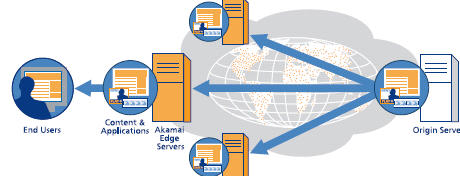Akamai beefs up its HD distribution capabilities

Via an interview with Akamai Chief Technology Officer Mike Afergan, Om's all over Akamai Technologies' announcement yesterday that via enhancements to its Content Delivery Network, it now feels more than up to the task of delivering high-def video over the Web.
"While broadband service providers like Verizon are putting fiber-based broadband connections in place, there are a large number of folks who are using connections in the 3-6 Mbps range.," Om explains. "The solution, Akamai argues is to come closer to the end user. Why? Because as the distance from the server increases, the throughput is dramatically reduced – even a slight distance increase can result in delivery problems."
To enhance its CDN, Akamai is using technologies from acquired solution providers Nine Systems and Red Swoosh.
Akamai does some of their own explaining here:
To realize this same vision and fidelity in the online world, a 2-hour feature-length movie wouldneed to be encoded at a bit rate of at least 6-8 Mbps, which would result in the file being a size of 5-8 GB. This presents numerous technical challenges to deliver such a high-quality, large file. For instance, delivering a file encoded at 6 Mbps to an audience of one Nielsen ratings point (1,102,000 households) would require 6.6 Terabits of sustained bandwidth, and that doesn’t even take into account latency and network congestion.
The availability of very large, last-mile bandwidth connections does not always mean that an end user will be able to completely leverage that access. A critical factor to enable high bit rate delivery of very large HD files is the proximity of the end-user to the server sending the file. As the distance from the server becomes greater, throughput dramatically decreases. Even a seemingly small distance can result in lost throughput due to lower throughput, higher packet loss, and increased latency.
As an example, the only way to achieve 10 to 20 Mbps throughput for typical PC end-users is if the server is less than 20 milliseconds away. The more latency, the longer it takes to download the file, which interrupts the viewing experience and results in a poor end-user experience. Compared with other centralized models, the results that Akamai's network offers high quality content are unmatched on a global scale.
Broadband subscribers are guaranteed to have a faster download, and enjoy a quality HD experience, when downloading content from servers nearby the request. With servers distributed in over 750 cities, Akamai addresses these technology requirements with its unique edge delivery model that reduces latency to levels necessary for a quality HD experience. Because distance matters for high-quality large files, all content, whether it is frequently or rarely requested, must be served closest to the end user. Akamai's unique technology automatically and instantly spreads popular content on-demand for better scalability.
In addition, many large HD videos are not always watched in their entirety. It is therefore optimal to locally cache only the portion of a file that is most requested by end users, which on average is the beginning of the file or movie. This partial caching of HD video enables both popular and less popular, long-tail content to be served from the edge to guarantee optimal performance.
"Akamai's goal is to be able to support 100 Terabits per second of traffic. Our flexible and distributed architecture uniquely positions us to realize that vision and we are aggressively progressing toward that goal," said Afergan. "We are also committed to the long-term objective of building an ecosystem linking content owners, network providers and video platform players to ensure a superior HD web experience wherever last-mile infrastructure permits."
Now we need to ask at least three questions:
Is there enough demand for this content?
Is there- or will there- soon be enough HD content to feed this beast?
What type of pricing models will prove sustainable for online hi-def content distributors?
